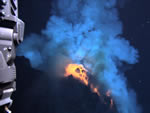
Submarine Volcanism
The EOI Geology Program aims to understand how submarine volcanic activity affects hydrothermal venting and life in the oceans. The ultimate heat source for all hydrothermal venting is molten rock within the Earth. Individual volcanic events bring this heat close to the surface where it can be released into the ocean, along with chemicals that sustain unique biological environments, both on and below the seafloor. Therefore, we are especially interested in studying the sites of recent submarine eruptions.
 Highlights:
Highlights:
Axial Seamount is an active submarine volcano in the NE Pacific that was the world’s first underwater volcano observatory. EOI scientists have long-term research projects there and recent results include the discovery of an eruption in April 2011, and monitoring of vertical motions of the seafloor that are used to forecast the volcano’s behavior.
EOI scientists made the first direct observations of deep-sea submarine eruptions at NW Rota volcano in the Mariana Arc and at W Mata volcano in the NE Lau Basin. These are both sites an on-going research (see the Expeditions page for the most recent visits to these volcanoes).
We have developed seafloor instruments for long-term monitoring of submarine volcanoes at cabled observatories. For example, a BPR/Tilt instrument was tested at the MARS cabled observatory, and realtime data can be viewed here. Similar instruments will be
deployed at Axial Seamount as part of the NE Pacific cabled observatory, which will be part of the National Science Foundation's Ocean Observatories Initiative.
Check out our interactive education and outreach web pages:
NeMO web site (previous research at a seafloor observatory at Axial Volcano)
NeMO Dive! site (simulated dive to the seafloor with a remotely operated vehicle) NeMO
Explorer web site (virtual seafloor landscapes, fly-thru movies,
panoramas)
NeMO
Education web site (curriculum for middle and high school teachers)
